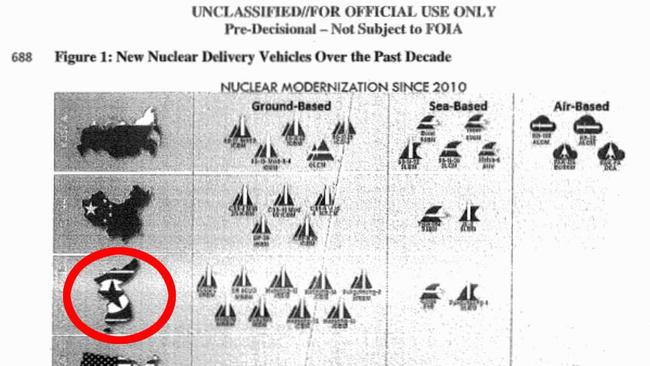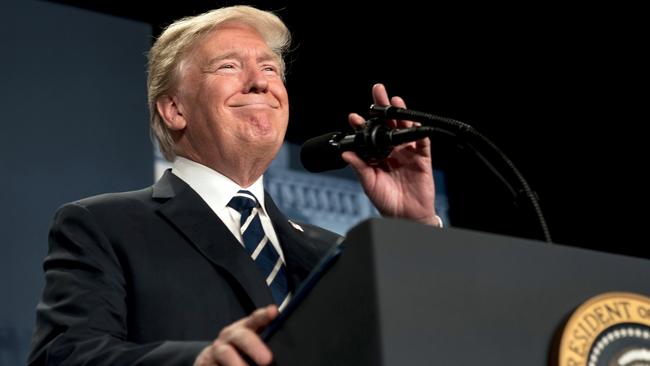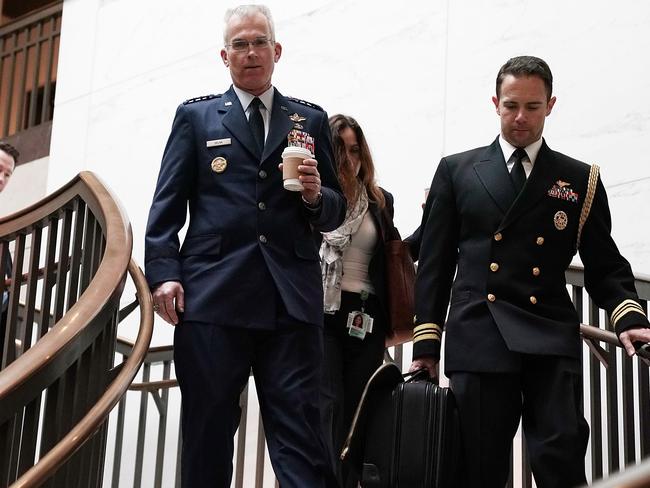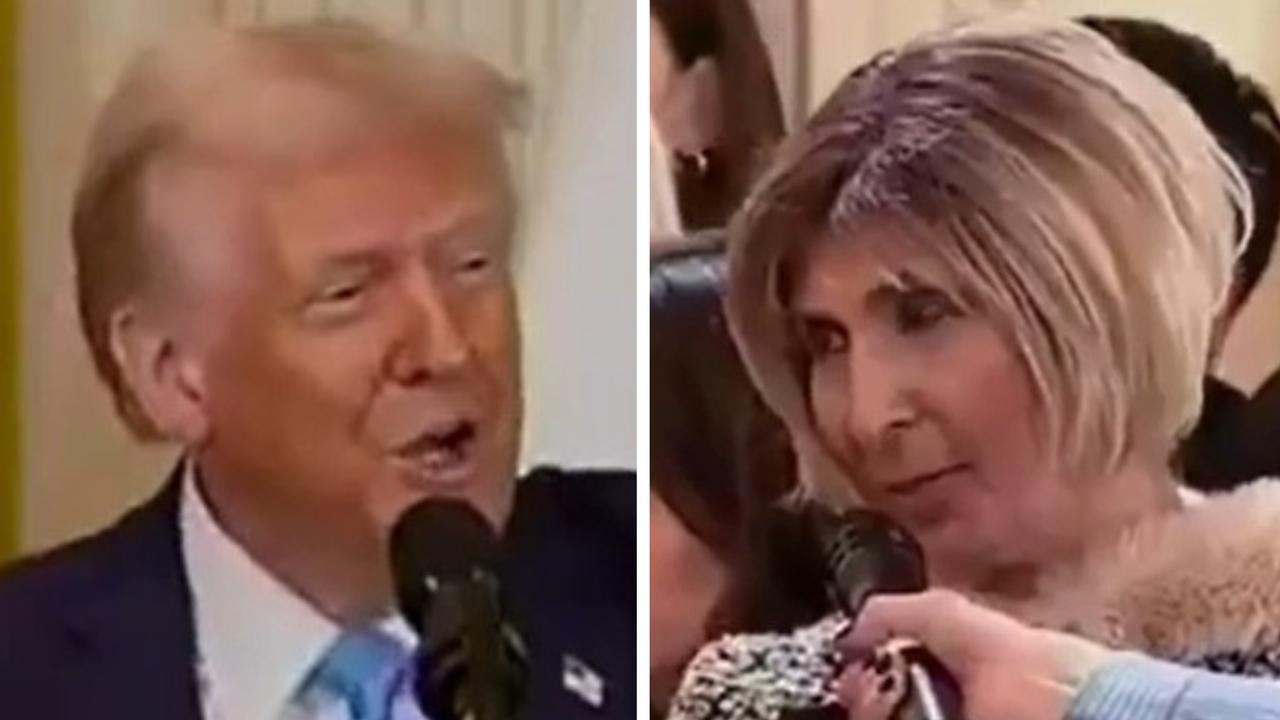North Korea: Trump administration’s ‘sloppy work’ in Nuclear Posture Review
AT FIRST glance you might not see what’s wrong with this map used in Donald Trump’s nuclear review. But it has left some experts baffled.

A DRAFT report of the Trump administration’s Nuclear Posture Review (NPR) has been slammed as embarrassing after featuring a graphic showing a very different looking North Korea.
The draft report, leaked two weeks ago, omits South Korea and instead shows the whole peninsula represented by the North’s flag.
Experts slammed the “sloppy work” in the report and said they hoped it would be corrected ahead of its final release tomorrow, US time.
Hans Kristensen, director of the Nuclear Information Project at the Federation of American Scientists, raised concerns about the map, tweeting the authors actually want to strengthen tailored deterrence.
There is much sloppy work in the Trump #NuclearPostureReview . The map of modernizations shows North Korea having taken over the entire peninsula. Since the authors want to strengthen tailored deterrence, they might want to correct the map for the final release tomorrow. pic.twitter.com/1HFB7EncAF
— Hans Kristensen (@nukestrat) February 1, 2018
The concerns over the graphic were echoed by Adam Mount, a senior fellow at the Centre for American Progress, who said the Pentagon could not release a policy document that failed to recognise South Korea.
So much in the NPR is amateur hour, but this is embarrassing, offensive, and unforgivable.
— Adam Mount (@ajmount) February 1, 2018
He also slammed it as embarrassing and unforgivable, adding it was the latest in a series of “avoidable offences”.
South Korea is a major US ally with the two countries forging strong military and economic ties.
Two weeks ago, Mr Mount said the leaked review translates Mr Trump’s impulses into an order for new, more usable nuclear options. He also called it “strategically risky”.
The NPR is used to determine the role of nuclear weapons in the security strategy of the US.
‘EMBARRASSING’ ERROR
John Blaxland, Professor of International Security and Intelligence Studies and director of ANU’s Southeast Asia Institute, said the mistake was embarrassing but wasn’t worth reading too much into.
“I see it more as sloppy editorial and drafting work than a substantive concern,” Prof Blaxland told news.com.au.
He said the Trump review marked a dramatic change in direction taken by the Obama administration.
“To be fair, Trump’s much more assertive nuclear posture comes at a time when Russia and China have themselves considerably expanded and modernised their arsenals and when North Korea has brought the issue back onto our TV screens and news feed headlines,” Prof Blaxland said.
“So Trump’s call for a dramatic increase in US nuclear weapons isn’t happening in a vacuum.”
However he said it did raise other concerns.

“There is a growing consensus among academic institutions and civil society organisations that the efficacy of nuclear weapons as a deterrent of state-on-state war has waned, if it ever worked effectively in the first place,” he said.
Prof Blaxland said some people argued it wasn’t the atomic weapons dropped on Japan in 1945 that led to Japan’s surrender but rather Russia’s declaration of war.
He also said the steps being proposed by the US today are likely to be extremely expensive and of dubious additional benefit.
“Having said that, there is a reasonably strong case for replacement and renewal of obsolete and obsolescent nuclear weapons build between 30 and 50 or 60 years ago by more modern equivalents,” he said.
“But a massive surge in numbers is hard to sustain, particularly given the vast competing pressures on the US economy and particularly on the modernisation of the conventional weapons and platforms of the US armed forces — much of which also dates back to the last days of the Cold War.”
NEW BOMB CALL
Speaking ahead of the briefing, chief Pentagon spokeswoman Dana White said this was a strategy which requires an investment in a credible nuclear deterrent with diverse capabilities, Inside Defence reported.
Underpinning the Trump nuclear doctrine is the concern that America’s nukes are so powerful that adversaries don’t believe they would ever be used.
The leaked draft version of the NPR indicates the Pentagon is calling for the development of a new type of low-yield nuclear bomb that is designed to be used on the battlefield, rather than to level a city.
These so-called tactical nuclear weapons have a limited explosive strength however remain powerful compared to conventional weapons.
The draft policy reveals Russia’s own low-yield nukes, within easy striking distance of Europe, provide “a coercive advantage in crises and at lower levels of conflict”.
“Correcting this mistaken Russian perception is a strategic imperative,” the document states.
Any weapon with an explosive blast of 20 kilotons or less is considered low-yield.
To put that in perspective, one kiloton is the same as 1000 tons of TNT; the bombs dropped on Hiroshima and Nagasaki at the end of World War II were about 15 and 20 kilotons respectively, so they would be considered low-yield today.
America already has a massive nuclear arsenal at its disposal, including 150 B-61 nukes stored across multiple European countries that can be configured for low-yield options, AFP reported.
The Pentagon’s nuclear policy draft, which euphemistically calls low-yield bombs “supplements”, states that increasing such weapons would help deter Russia and other nations.
“These supplements will enhance deterrence by denying potential adversaries any mistaken confidence that limited nuclear employment can provide a useful advantage over the United States and its allies,” states the policy, which was obtained by the Huffington Post.

The proposed policy says the Defence Department and the National Nuclear Security Administration will develop a low-yield submarine-launched ballistic missile for deployment and, in the longer term, develop a sea-launched cruise missile.
America currently has an estimated arsenal of about 7000 nuclear warheads, second only to Russia, which has a few hundred more. The new missile types wouldn’t add to the stockpile, but rather would reconfigure existing warheads.
‘NO GOOD NUKE’
Critics are already warning the NPR could trigger another arms race and raise the risk of miscalculations that might spark an atomic conflict.
Beatrice Fihn, executive director of International Campaign to Abolish Nuclear Weapons (ICAN), said the Trump review raised some serious concerns.
“The risk of use for nuclear weapons has always been unacceptably high,” she said.
“The new Trump nuclear doctrine is to deliberately increase that risk. It is an all-out attempt to take nuclear weapons out of the silos and onto the battlefield.
“This policy is a shift from one where the use of nuclear weapons is possible to one where the use of nuclear weapons is likely.”
She also said there was no such thing as a good nuclear weapon.
CONCERNS GROW
The Union of Concerned Scientists has also raised some concerns about the review and has said the gap between China and the US is too wide to argue Washington is lagging behind in a significant way.
While acknowledging Beijing has made significant advances in its nuclear capabilities, it said China’s arsenal is smaller than the US had in 1950.
In a White Paper released last month, they also argue there’s little evidence China is pursuing “entirely new” nuclear capabilities.
The People for Nuclear Disarmament said the leaked NPR made global thermonuclear war more, not less, likely and global nuclear arms racing more probable.
Nuclear disarmament campaigner John Hallam said Mr Trump was looking for ways in which he could differentiate himself from, and take credit for, the immense expansion of US nuclear infrastructure initiated by former president Obama.
Mr Hallam said there is considerable continuity between the Obama and the Trump approach but there was a key difference.
“The only important difference — and it certainly is important — is that while under Obama, the direction of the US nuclear arsenal was officially down it is not officially up,” he said.
“Trump makes no bones about wanting to expand US nuclear capabilities. Never mind if they don’t need them. Never mind if it initiates an arms race or never mind if it makes an apocalypse more likely.
“Obama was also more likely to at least think about risk reduction measures such as de-alerting and no-first-use. Those measures are now clearly not to be considered.”
— With AFP




